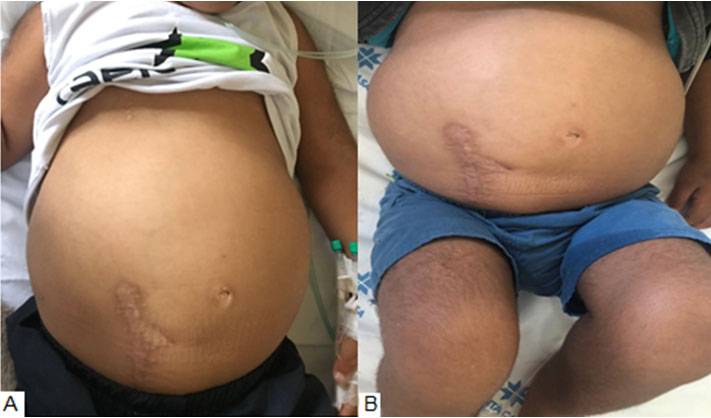 |
Clinical Image
Tension pneumocephalus following ventriculoperitoneal shunt insertion
1 MD, Pulmonologist, Intensivist, ICU of Athens General Hospital Korgialenio-Benakio Red Cross, Athens, Greece
2 MD, Internist, ICU of Athens General Hospital Korgialenio-Benakio Red Cross, Athens, Greece
Address correspondence to:
Marinakis Giorgos
Athanasaki 2, 11526 Athens,
Greece
Message to Corresponding Author
Article ID: 101104Z01MG2020
Access full text article on other devices

Access PDF of article on other devices

How to cite this article
Giorgos M, Gkouvelos G. Tension pneumocephalus following ventriculoperitoneal shunt insertion. Int J Case Rep Images 2020;11:101104Z01MG2020.ABSTRACT
No Abstract
Keywords: Cerebrospinal fluid, Tension pneumocephalus, Ventriculoperitoneal
Case Report
A 76-year-old man, with a history of arterial hypertension and ischemic stroke without focal deficits three years ago, was admitted to our hospital for embolization of ruptured anterior communicating artery aneurysm. The following day of the embolization, an extracranial cerebrospinal fluid (CSF) shunt was placed due to acute hydrocephalus. During his stay in the neurosurgery department, he developed acute respiratory failure type 2, and was intubated and transferred to our intensive care unit (ICU). In the ICU, the patient remained with normal-sized pupils, sluggishly reacting to direct light. Ten days later, while he was breathing spontaneously via tracheostomy tube and with improving neurological condition (GCS 11/15, E4 V1 M6), the extracranial CSF shunt was removed, and a ventriculoperitoneal (VP) shunt was placed. After less than 48 hours, his level of consciousness progressively deteriorated, and he developed anisocoria (dilatation of the right pupil) without light reflex. The head computed tomography (CT) scan showed an amount of air in the right frontal subdural space causing shifting of the midline to the left (Figure 1). The patient’s clinical condition improved impressively after the aspiration of approximately 60 mL of air with a 20-gauge needle, from a small hole in the frontal bone, through which the previous extracranial shunt was inserted (Figure 2). It is worth mentioning that the procedure took place on his ICU bed. Three days later, he transferred back to the neurosurgery department, presenting similar neurological status as prior to the surgery.
Discussion
Tension pneumocephalus (TP) is a life-threatening neurosurgical condition, which requires prompt intervention. The clinical findings are nonspecific, presumably reflecting increasing brain parenchymal compression. Case reports concerning pneumocephalus complicating VP shunt insertion are extremely rare. Most of them described the occurrence of pneumocephalus months or years following the VP shunt insertion. As far as we are aware, this is the third case of early postoperative TP after shunt surgery described in the literature and the first in our ICU department [1],[2],[3]. It is important to note that in our case the pathognomonic radiographic sign of TP, called “Mount Fuji’’ (separation of both frontal lobes away from the falx cerebri in the midline), did not appear. The short period of time that intervened between the surgery and the alteration of patient’s level of consciousness could be one explanation for the latter.
Conclusion
Even though early onset TP following VP shunt insertion is unusual, our case report indicates that close monitoring of the patients after the specific surgery is lifesaving.
REFERENCES
1.
Baradaa W, Najjar M, Beydouna A. Early onset tension pneumocephalus following ventriculoperitoneal shunt insertion for normal pressure hydrocephalus: A case report. Clin Neurol Neurosurg 2009;111(3):300–2. [CrossRef]
[Pubmed]

2.
Aydoseli A, Akcakaya MO, Aras Y, Boyali O, Unal OF. Emergency management of an acute tension pneumocephalus following ventriculoperitoneal shunt surgery for normal pressure hydrocephalus. Turk Neurosurg 2013;23(4):564–7. [CrossRef]
[Pubmed]

3.
Harvey JJ, Harvey SC, Belli A. Tension pneumocephalus: The neurosurgical emergency equivalent of tension pneumothorax. BJR Rep Case 2016;2(2):20150127. [CrossRef]
[Pubmed]

SUPPORTING INFORMATION
Author Contributions
Marinakis Giorgos - Conception of the work, Design of the work, Acquisition of data, Analysis of data, Drafting the work, Revising the work critically for important intellectual content, Final approval of the version to be published, Agree to be accountable for all aspects of the work in ensuring that questions related to the accuracy or integrity of any part of the work are appropriately investigated and resolved.
Grigoris Gkouvelos - Conception of the work, Design of the work, Acquisition of data, Analysis of data, Drafting the work, Revising the work critically for important intellectual content, Final approval of the version to be published, Agree to be accountable for all aspects of the work in ensuring that questions related to the accuracy or integrity of any part of the work are appropriately investigated and resolved.
Guarantor of SubmissionThe corresponding author is the guarantor of submission.
Source of SupportNone
Consent StatementWritten informed consent was obtained from the patient for publication of this article.
Data AvailabilityAll relevant data are within the paper and its Supporting Information files.
Conflict of InterestAuthors declare no conflict of interest.
Copyright© 2020 Marinakis Giorgos et al. This article is distributed under the terms of Creative Commons Attribution License which permits unrestricted use, distribution and reproduction in any medium provided the original author(s) and original publisher are properly credited. Please see the copyright policy on the journal website for more information.







